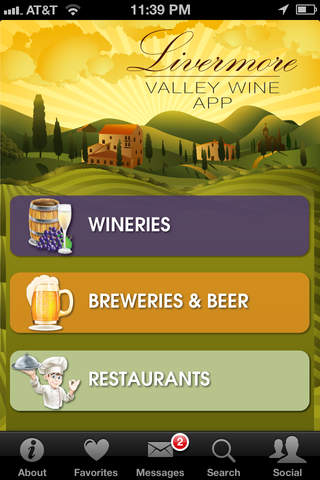Livermore Valley Wineries
Detailed App Info:
Application Description
Less than an hour east of San Francisco, Livermore Valley Wine Country welcomes visitors with a flourish expanse of vineyards, wineries, and wine country experiences. Amid picturesque canyons, ridges and outposts of suburbia, the lush vines and convivial tasting rooms increasingly define the quality of life in the valley. To the delight of residents and visitors alike, the region is enjoying a wine renaissance harking back to the golden years of early California wine history.
One of California's oldest wine regions, the Livermore Valley played a pivotal role in shaping California's wine industry. Spanish missionaries planted the first wine grapes in the Livermore Valley in the 1760s. In the 1840s, California pioneers looking for outstanding vineyard sites began planting grapes in the region. Robert Livermore planted the first commercial vines in the 1840s. Pioneer winemakers C. H. Wente, James Concannon, and Charles Wetmore recognized the area's winegrowing potential and founded their wineries in the early 1880s.
Livermore Valley captured America's first international gold medal for wine in 1889 at the Paris Exposition, putting California on the world wine map.
Livermore Valley wineries were the first to bottle varietal labeled Chardonnay, Sauvignon Blanc and Petite Sirah. Nearly 80% of California's Chardonnay vines trace their genetic roots to a Livermore Valley clone. Livermore Valley also boasted more than 50 wineries until Prohibition and contributed significantly to the state's enology and viticulture that lives on today. Innovations developed in the Livermore Valley include overhead irrigation, mechanical harvesting and roller crushing in the vineyard.
Attracted to the rich winemaking tradition, climate, soil and geography, new winemakers and vineyardists are working alongside fifth generation winegrowers to create this Livermore Valley wine renaissance. The region now has over 40 wineries, with several more about to open, and more than 5,000 acres of vineyards. Wineries vary in size from limited release, 100-case labors of love to 400,000-case industry heavyweights, and grapes range from familiar Merlot and Chardonnay to Italian, Rhone and Spanish varieties. Welcoming tasting rooms showcase award-winning wines and offer year around activities. In addition to the myriad happenings at individual wineries, the Livermore Valley Winegrowers Association sponsors several consumer events each year, showcasing the talent, energy and fine wines of the region.
The Livermore Valley iPhone app concentrates on the Livermore area wineries, along with a sampling of local businesses and events for the user. We don't try to be a comprehensive directory of restaurants, shopping or activities, but provide enough of a selection for wine lovers spending a day or weekend in Livermore to stay busy.
One of California's oldest wine regions, the Livermore Valley played a pivotal role in shaping California's wine industry. Spanish missionaries planted the first wine grapes in the Livermore Valley in the 1760s. In the 1840s, California pioneers looking for outstanding vineyard sites began planting grapes in the region. Robert Livermore planted the first commercial vines in the 1840s. Pioneer winemakers C. H. Wente, James Concannon, and Charles Wetmore recognized the area's winegrowing potential and founded their wineries in the early 1880s.
Livermore Valley captured America's first international gold medal for wine in 1889 at the Paris Exposition, putting California on the world wine map.
Livermore Valley wineries were the first to bottle varietal labeled Chardonnay, Sauvignon Blanc and Petite Sirah. Nearly 80% of California's Chardonnay vines trace their genetic roots to a Livermore Valley clone. Livermore Valley also boasted more than 50 wineries until Prohibition and contributed significantly to the state's enology and viticulture that lives on today. Innovations developed in the Livermore Valley include overhead irrigation, mechanical harvesting and roller crushing in the vineyard.
Attracted to the rich winemaking tradition, climate, soil and geography, new winemakers and vineyardists are working alongside fifth generation winegrowers to create this Livermore Valley wine renaissance. The region now has over 40 wineries, with several more about to open, and more than 5,000 acres of vineyards. Wineries vary in size from limited release, 100-case labors of love to 400,000-case industry heavyweights, and grapes range from familiar Merlot and Chardonnay to Italian, Rhone and Spanish varieties. Welcoming tasting rooms showcase award-winning wines and offer year around activities. In addition to the myriad happenings at individual wineries, the Livermore Valley Winegrowers Association sponsors several consumer events each year, showcasing the talent, energy and fine wines of the region.
The Livermore Valley iPhone app concentrates on the Livermore area wineries, along with a sampling of local businesses and events for the user. We don't try to be a comprehensive directory of restaurants, shopping or activities, but provide enough of a selection for wine lovers spending a day or weekend in Livermore to stay busy.
Requirements
Your mobile device must have at least 3.71 MB of space to download and install Livermore Valley Wineries app. Livermore Valley Wineries was updated to a new version. Purchase this version for $0.00
If you have any problems with installation or in-app purchase, found bugs, questions, comments about this application, you can visit the official website of GoLocalApps 1776 Productions at http://support.golocalapps.com.
Copyright © 2012 GoLocalApps





